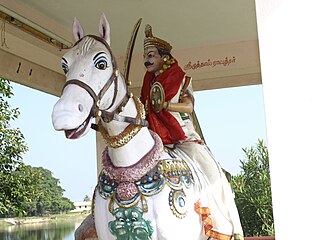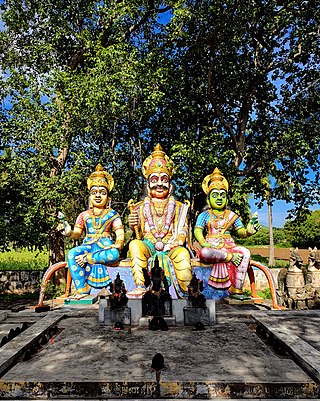
Karanthai Tamil Sangam is a Tamil language society in Tamil Nadu, India. The society was founded in 1911 to promote the language. It is one of the modern Tamil Sangams.

Karanthai Tamil Sangam is a Tamil language society in Tamil Nadu, India. The society was founded in 1911 to promote the language. It is one of the modern Tamil Sangams.
Karanthai Tamil Sangam was founded on 14 May 1911 in Karanthattankudi (also known as Karunthattaikudi and Karanthai), a suburb of Thanjavur, Tamil Nadu. The society was founded by Radhakrishna Pillai with his brother Umamaheswara Pillai as its first president. [1] [2] The Sangam passed a resolution in 1920 to declare Tamil as classical language. [3] In a meeting on 27 August 1937, it condemned the imposition of Hindi in the educational institutions. [4]
The society started a literacy journal Tamil polil in 1925. [1] It conducts monthly meetings and seminars on Tamil literature. [5] It established educational institutions to provide Tamil education. [1]

Tamil is a Dravidian language natively spoken by the Tamil people of South Asia. Tamil is an official language of the Indian state of Tamil Nadu, the sovereign nations of Sri Lanka and Singapore, and the Indian Union territory of Puducherry. Tamil is also spoken by significant minorities in the four other South Indian states of Kerala, Karnataka, Andhra Pradesh and Telangana, and the Union Territory of the Andaman and Nicobar Islands. It is also spoken by the Tamil diaspora found in many countries, including Malaysia, Myanmar, South Africa, United Kingdom, United States, Canada, Australia and Mauritius. Tamil is also natively spoken by the Sri Lankan Moors. One of 22 scheduled languages in the Constitution of India, Tamil was the first to be classified as a classical language of India.

The Tamil people, also known as Tamilar, Tamilians, or simply Tamils, are a Dravidian ethnolinguistic group who natively speak the Tamil language and trace their ancestry mainly to India's southern state of Tamil Nadu, the union territory of Puducherry, and to Sri Lanka. The Tamil language is one of the world's longest-surviving classical languages, with over 2000 years of Tamil literature, including the Sangam poems, which were composed between 300 BCE and 300 CE. People who speak Tamil as their mother tongue and are born in Tamil clans are considered Tamils.

The Tamil Sangams were assemblies of Tamil scholars and poets that, according to traditional Tamil accounts, occurred in the remote past. Scholars believe that these assemblies originally known as kooṭam or "gathering," which was also a name for Madurai. Three assemblies are described. The legend has it that the first two were held in cities since "taken by the sea", the first being called Kapatapuram, and the third was held in the present-day city of Madurai.
Tolkāppiyam, also romanised as Tholkaappiyam, is the most ancient extant Tamil grammar text and the oldest extant long work of Tamil literature. It is the earliest Tamil text mentioning Gods often identified as Hindu deities. Mayyon as, Seyyon as (Skandha), Vendhan as (Indra), Varuna as (Varuna) and Kotṟavai as are the gods mentioned. The surviving manuscripts of the Tolkappiyam consists of three books (atikaram), each with nine chapters (iyal), with a cumulative total of 1,610 (483+463+664) sutras in the nūṛpā meter. It is a comprehensive text on grammar, and includes sutras on orthography, phonology, etymology, morphology, semantics, prosody, sentence structure and the significance of context in language.

Tulu Nadu or Tulunad, also called Bermere Srishti or Parashurama Srishti, is a region and a proposed state on the southwestern coast of India. The Tulu people, known as 'Tuluva', speakers of Tulu, a Dravidian language, are the preponderant ethnic group of this region. South Canara, an erstwhile district and a historical area, encompassing the undivided territory of the contemporary Dakshina Kannada and Udupi districts of Karnataka State and Kasaragod district of Kerala state forms the cultural area of the Tuluver.

Robert Caldwell was a missionary for London Missionary Society. He arrived in British India at age 24, and studied the local language to spread the word of the Bible in a vernacular language, studies that led him to author a text on comparative grammar of the South Indian languages. In his book, Caldwell proposed that there are Dravidian words in the Hebrew of the Old Testament, the archaic Greek language, and the places named by Ptolemy.

Kumari Kandam is a mythical continent, believed to be lost with an ancient Tamil civilization, supposedly located south of present-day India in the Indian Ocean. Alternative names and spellings include Kumarikkandam and Kumari Nadu.

The Sangam literature historically known as 'the poetry of the noble ones' connotes the ancient Tamil literature and is the earliest known literature of South India. The Tamil tradition and legends link it to three literary gatherings around Madurai and Kapāṭapuram : the first over 4,440 years, the second over 3,700 years, and the third over 1,850 years before the start of the common era. Scholars consider this Tamil tradition-based chronology as ahistorical and mythical. Most scholars suggest the historical Sangam literature era spanned from c. 300 BCE to 300 CE, while others variously place this early classical Tamil literature period a bit later and more narrowly but all before 300 CE. According to Kamil Zvelebil, a Tamil literature and history scholar, the most acceptable range for the Sangam literature is 100 BCE to 250 CE, based on the linguistic, prosodic and quasi-historic allusions within the texts and the colophons.

Tamilakam is the geographical region inhabited by the ancient Tamil people, covering the southernmost region of the Indian subcontinent. Tamilakam covered today's Tamil Nadu, Kerala, Puducherry, Lakshadweep and southern parts of Andhra Pradesh and Karnataka. Traditional accounts and the Tolkāppiyam referred to these territories as a single cultural area, where Tamil was the natural language and permeated the culture of all its inhabitants. The ancient Tamil country was divided into kingdoms. The best known among them were the Cheras, Cholas, Pandyans and Pallavas. During the Sangam period, Tamil culture began to spread outside Tamilakam. Ancient Tamil settlements were also established in Sri Lanka and the Maldives (Giravarus).
Bharatha People also known as Bharatakula and Paravar, is an ethnicity in the island of Sri Lanka. Earlier considered a caste of the Sri Lankan Tamils, they got classified as separate ethnic group in the 2001 census. They are descendant of Tamil speaking Paravar of Southern India who migrated to Sri Lanka under Portuguese rule. They live mainly on the western coast of Sri Lanka and mainly found in the cities of Mannar, Negombo and Colombo.
Brahmin Tamil is the name of a dialect of Tamil traditionally spoken by Tamil Brahmins. The dialect, largely, uses Classical Tamil along with a heavy proportion of Sanskrit derivatives. According to the linguist Sabari Ganesh, Brahmin Tamil dialect is closest to the Central Tamil dialect, particularly, the variant spoken by the once dominant and highly educated community colloquial spoken Tamil of Vellalars and Mudaliyars.

Devaneya Pavanar was an Indian scholar who wrote over 35 research volumes on Tamil language and literature. Additionally, he was a staunch proponent of the "Pure Tamil movement" and initiated the Etymological Dictionary Project primarily to bring out the roots of Tamil words and their connections and ramifications with Nostratic studies.

The Dravidian peoples, Dravidian-speakers or Dravidians, are a linguistic and cultural group living primarily in Southern Asia and speaking any of the Dravidian languages. There are around 250 million native speakers of Dravidian languages. Dravidian speakers form the majority of the population of South India and are natively found in India, Pakistan, Afghanistan, Bangladesh, the Maldives, Nepal, Bhutan and Sri Lanka. Dravidian peoples are also present in Singapore, Mauritius, Malaysia, France, South Africa, Myanmar, East Africa, the Caribbean, and the United Arab Emirates through recent migration.

The Rowther are originally a Tamil community from the Indian state of Tamil Nadu and Kerala. they were converted to Islam by the preacher Nathar Shah. Even after conversion they retained their caste name. they were elite cavalrymen of the Chola and Pandya kingdoms. They were traditionally a martial clan like the Maravars, and constitute large part of the multi-ethnic Tamil Muslim community. Rowthers have also been found as Tamil polygars, zamindars and chieftains from the 16th to 18th centuries. The traditional homelands of the Rowthers were in the interior of Southern Tamilakam.
The First Sangam period or the First Academy, also known as the Head Sangam period, was a legendary period in the history of Ancient Tamilakam said to be the foremost of Tamil Sangams, known in the Tamil language as koodal or "gathering". It is the first of three Tamil Sangams of Classical Tamil literature. While most historians accept the historicity of this literature, they also understand that some literary academies would have held Pandyan patronage. This is not to be confused with the historical Third Sangam period which lasted roughly from 600 BCE to 300 CE.

The early Dravidian religion constituted a non-Vedic form of Hinduism in that they were either historically or are at present Āgamic. The Agamas are non-Vedic in origin, and have been dated either as post-Vedic texts, or as pre-Vedic compositions. The Agamas are a collection of Tamil and Sanskrit scriptures chiefly constituting the methods of temple construction and creation of murti, worship means of deities, philosophical doctrines, meditative practices, attainment of sixfold desires and four kinds of yoga. The worship of tutelary deities and sacred flora and fauna in Hinduism is also recognized as a survival of the pre-Vedic Dravidian religion. Dravidian linguistic influence on early Vedic religion is evident; many of these features are already present in the oldest known Indo-Aryan language, the language of the Rigveda, which also includes over a dozen words borrowed from Dravidian. The linguistic evidence for Dravidian impact grows increasingly strong as one moves from the Samhitas down through the later Vedic works and into the classical post-Vedic literature. This represents an early religious and cultural fusion or synthesis between ancient Dravidians and Indo-Aryans that went on to influence Indian civilisation.
Gnanou Diagou (1877–1959) was a lawyer and professor of law in Pondicherry, India. He is known for translating the Tirukkural into French.
The dating of the Tirukkural, and by extension the period of its author Valluvar, has been a subject of intense debate among scholars for centuries, and it continues to remain so. The Kural is variously dated between 300 BCE and 5th century CE. According to Blackburn, the "current scholarly consensus" dates the text and the author to approximately 500 CE. The Tamil Nadu government has ratified 31 BCE as the year of birth of Valluvar. Still the precise date as to when Valluvar completed writing the Kural text remains murky. This article speaks about various dates arrived at by various scholars over time.
Saminathan Dharmambal (1890–1959) was an Indian social activist and women's rights activist. She is remembered for her contributions to the Tamil language and involvement in the Anti-Hindi agitation of 1937–40. In 1951, she was given the title of vira Tamil annai.

Vijayamangalam Jain temple also known as Chandrapraba Tirtankarar Temple is a Jain temple in the town of Vijayamangalam in Erode district, Tamil Nadu.